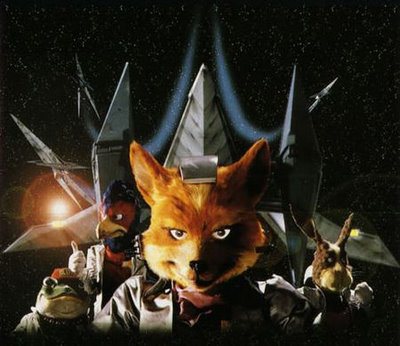
It’s been 20 years since the Arwings first launched and the team known as Star Fox reported for duty. In 1993, Star Fox (or Starwing in the UK) came out for the Super Nintendo. Since then, we’ve had five distinct games and one remake bearing the Star Fox name, both on Nintendo home consoles and handhelds. The series has become Nintendo’s seminal sci-fi shoot ’em up franchise, but it’s also branched out to include action-adventure and strategy elements as well. Fans of the Star Fox games love them for their intense action, re-playability, and chatty characters. Star Fox has had its highs and lows, but at any rate, 20 years is a grand milestone to celebrate.
Over the coming week, we’re going to be looking at the characters, Star Fox’s greatest moments, the music, and all the fun facts and trivia. But right now, let’s take a look back at the history and accomplishments of the team led by the galactic vulpes. Check your G-Diffuser systems, because here we go!
It All Started With a Microchip
Many great video games throughout time were originally created as tech demos to experiment with the capabilities of hardware. Such was the case with the original Star Fox.
 In the early 1990s, Nintendo was experimenting with ways to allow the SNES to display 3D polygonal graphics. While the hardware of the console couldn’t render such things, the crafty designers figured out that hardware built into the game cartridges could greatly augment the graphical capabilities of the SNES. Nintendo teamed up with Argonaut Games to design the Super FX Chip, a powerful (for the time) co-processor which could expand the graphics of the Super Nintendo by several times. Those interested in the technical side of things can read about the Super FX Chip’s exact specs here.
In the early 1990s, Nintendo was experimenting with ways to allow the SNES to display 3D polygonal graphics. While the hardware of the console couldn’t render such things, the crafty designers figured out that hardware built into the game cartridges could greatly augment the graphical capabilities of the SNES. Nintendo teamed up with Argonaut Games to design the Super FX Chip, a powerful (for the time) co-processor which could expand the graphics of the Super Nintendo by several times. Those interested in the technical side of things can read about the Super FX Chip’s exact specs here.
So Nintendo had this fancy chip, but now there needed to be a game to harness its power. Nintendo EAD teamed up with Super FX chip architect Argonaut to come up with a game the likes of which had never been seen before on a home console. The responsibilities of designing the new game fell to Katsuya Eguchi, a designer on Super Mario Bros. 3 (now the man in charge of the Animal Crossing series) and Shigeru Miyamoto. After they tested various ideas for the Super FX game, the designers settled with a 3D space shooter. Miyamoto recalls how the idea came about:
“I thought maybe we could make a game by rendering a background and having something three-dimensional move on top of it, and it looked like we might be able to make a space adventure with a fighter aircraft flying through the air and over planetary surfaces.”
From there, a new adventure was born. Miyamoto wanted the game to stand out from other typical sci-fi properties of the time, which featured robots and monsters, so animals were put into the cockpit of the spaceships. Takaya Imamura, who had worked on F-Zero before, designed the characters we would eventually come to know as Fox, Peppy, Slippy and Falco.

Each animal featured in the game came from a certain origin. Miyamoto was inspired to use a fox character based on the Fushimi Inari Taisha shrine close to Nintendo HQ in Kyoto. For the other characters, Imamura drew from Japanese folklore, where he got the characters of a bird and a hare. Dogs and monkeys would become the allied and enemy forces from an old Japanese idiom “fighting like dogs and monkeys.” And then there was a toad. Apparently, there was an odd fellow who worked at EAD who used a frog as a personal mascot, and even wrote “ribbit” on his memos. He inspired Imamura to add an amphibious friend to the cast of characters that was taking shape.
The final game featured a team of mercenary figher pilots called Star Fox. The group was led by Fox McCloud, and included the pilots Falco, Peppy, and Slippy. An evil monkey scientist named Andross was bent on taking over the Lylat System, and he had conquered all but the capital planet of Corneria before General Pepper enlisted the help of Star Fox to stop the encroaching Venomian forces. The game featured polygonal ships called Arwings that went forward on a set path, destroying enemies, gaining power-ups, and doing tactical rolls. Three branching paths through the Lylat system were possible, each of a different difficulty.

Star Fox was released on the Super Nintendo February 21, 1993 in Japan. It came soon after to America on March 23rd and to Europe on June 3rd of the same year. However, in the UK, it was known as StarWing due to some copyright disputes with an older game. Star Fox quickly became a best selling game and was given high reviews from many gaming publications. Very few, if any, other games on a home console had the graphics of Star Fox, which were quite ahead of their time. Work on a sequel soon began, but it was not meant to be. At least not yet…




 ShareThis
ShareThis







Talk about a trip down memory lane. Great article, Kyle.
Maybe I should give Command a shot.